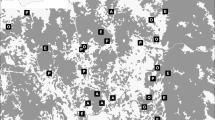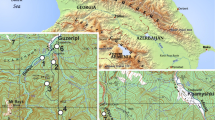Abstract
Traditionally managed mountain grasslands are declining as a result of abandonment or intensification of management. Based on a common chronosequence approach we investigated species compositions of 16 taxonomic groups on traditionally managed dry pastures, fertilized and irrigated hay meadows, and abandoned grasslands (larch forests). We included faunal above- and below-ground biodiversity as well as species traits (mainly rarity and habitat specificity) in our analyses. The larch forests showed the highest species number (345 species), with slightly less species in pastures (290 species) and much less in hay meadows (163 species). The proportion of rare species was highest in the pastures and lowest in hay meadows. Similar patterns were found for specialist species, i.e. species with a high habitat specificity. After abandonment, larch forests harbor a higher number of pasture species than hay meadows. These overall trends were mainly supported by spiders and vascular plants. Lichens, bryophytes and carabid beetles showed partly contrasting trends. These findings stress the importance to include a wide range of taxonomic groups in conservation studies. All in all, both abandonment and intensification had similar negative impacts on biodiversity in our study, underlining the high conservation value of Inner-Alpine dry pastures.





Similar content being viewed by others
Change history
29 May 2019
In the original publication of the article, Figure 2 was published without the labels. The corrected figure and figure legend are provided in this Correction.
29 May 2019
In the original publication of the article, Figure 2 was published without the labels. The corrected figure and figure legend are provided in this Correction.
References
Bennett VJ, Betts MG, Smith WP (2014) Influence of thermal conditions on habitat use by a rare spring-emerging butterfly Euphydryas editha taylori. J Appl Entomol 138:623–634. https://doi.org/10.1111/jen.12137
Block W (1966) Some characteristics of the Macfadyen high gradient extractor for soil micro-arthropods. Oikos 17:1–9
Boch S, Prati D, Scho I, Fischer M (2016) Lichen species richness is highest in non-intensively used grasslands promoting suitable microhabitats and low vascular plant competition. Biodivers Conserv 25:225–238. https://doi.org/10.1007/s10531-015-1037-y
Braschler B, Baur B (2016) Diverse effects of a seven-year experimental grassland fragmentation on major invertebrate groups. PLoS ONE. https://doi.org/10.1371/journal.pone.0149567
Braun-Blanquet J (1964) Pflanzensoziologie, 3rd edn. Springer, Wien
Brown AM, Warton DI, Andrew NR et al (2014) The fourth-corner solution—using predictive models to understand how species traits interact with the environment. Methods Ecol Evol 5:344–352. https://doi.org/10.1111/2041-210X.12163
Cadotte MW, Tucker CM (2017) Should environmental filtering be abandoned? Trends Ecol Evol 32:429–437. https://doi.org/10.1016/j.tree.2017.03.004
Clavel J, Julliard R, Devictor V (2011) Worldwide decline of specialist species: toward a global functional homogenization? Front Ecol Environ 9:222–228. https://doi.org/10.1890/080216
Commission European (2013) Interpretation manual of European Union habitats. CEC, Brussels
Cremene C, Groza G, Rakosy L et al (2005) Alterations of steppe-like grasslands in Eastern Europe: a threat to regional biodiversity hotspots. Conserv Biol 19:1606–1618. https://doi.org/10.1111/j.1523-1739.2005.00084.x
Dierßen K (1990) Einführung in die Pflanzensoziologie (Vegetationskunde). Wissenschaftliche Buchgesellschaft, Darmstadt
Egarter Vigl L, Schirpke U, Tasser E, Tappeiner U (2016) Linking long-term landscape dynamics to the multiple interactions among ecosystem services in the European Alps. Landsc Ecol 31:1903–1918. https://doi.org/10.1007/s10980-016-0389-3
Ellenberg H, Leuschner C (2010) Vegetation Mitteleuropas mit den Alpen, 6th edn. Verlag Eugen Ulmer, Stuttgart
Ellenberg H, Weber HE, Düll R et al (1992) Zeigerwerte von Pflanzen in Mitteleuropa. Scr Geobot 18:1–248
Ernst LM, Tscharntke T, Batáry P (2017) Grassland management in agricultural vs. forested landscapes drives butter fly and bird diversity. Biol Conserv 216:51–59. https://doi.org/10.1016/j.biocon.2017.09.027
Fahrig L, Baudry J, Brotons L et al (2011) Functional landscape heterogeneity and animal biodiversity in agricultural landscapes. Ecol Lett 14:101–112. https://doi.org/10.1111/j.1461-0248.2010.01559.x
Fartmann T, Krämer B, Stelzner F, Poniatowski D (2012) Orthoptera as ecological indicators for succession in steppe grassland. Ecol Indic 20:337–344. https://doi.org/10.1016/j.ecolind.2012.03.002
Gámez-Virués S, Perović DJ, Gossner MM et al (2015) Landscape simplification filters species traits and drives biotic homogenization. Nat Commun. https://doi.org/10.1038/ncomms9568
Graf R, Müller M, Korner P et al (2014) 20% loss of unimproved farmland in 22 years in the Engadin, Swiss Alps. Agric Ecosyst Environ 185:48–58. https://doi.org/10.1016/j.agee.2013.12.009
Grandchamp A-C, Bergamini A, Stofer S et al (2005) The influence of grassland management on ground beetles (Carabidae, Coleoptera) in Swiss montane meadows. Agric Ecosyst Environ 110:307–317. https://doi.org/10.1016/j.agee.2005.04.018
Halada L, David S, Hresko J et al (2017) Changes in grassland management and plant diversity in a marginal region of the Carpathian Mts. in 1999–2015. Sci Total Environ 609:896–905. https://doi.org/10.1016/j.scitotenv.2017.07.066
Hector A, Bagchi R (2007) Biodiversity and ecosystem multifunctionality. Nature 448:188–190
Hülber K, Moser D, Sauberer N et al (2017) Plant species richness decreased in semi-natural grasslands in the Biosphere Reserve Wienerwald, Austria, over the past two decades, despite agri-environmental measures. Agric Ecosyst Environ 243:10–18. https://doi.org/10.1016/j.agee.2017.04.002
Kempson D, Lloyd M, Ghelardi R (1963) A new extractor for woodland litter. Pedobiologia (Jena) 3:1–21
Lacasella F, Gratton C, De Felici S et al (2015) Asymmetrical responses of forest and “beyond edge” arthropod communities across a forest-grassland ecotone. Biodivers Conserv 24:447–465. https://doi.org/10.1007/s10531-014-0825-0
Lasanta T, Arnáez J, Pascual N et al (2017) Space–time process and drivers of land abandonment in Europe. CATENA 149:810–823. https://doi.org/10.1016/j.catena.2016.02.024
Lasen C, Wilhalm T (2004) Natura-2000-Lebensräume in Südtirol. Abteilung Natur und Landschaft, Autonome Provinz Bozen-Südtirol, Bolzano
Law BS, Dickman CR (1998) The use of habitat mosaics by terrestrial vertebrate fauna: implications for conservation and management. Biodivers Conserv 7:323–333
Lengyel S, Déri E, Magura T (2016) Species richness responses to structural or compositional habitat diversity between and within grassland patches: a multi-taxon approach. PLoS ONE. https://doi.org/10.1371/journal.pone.0149662
Lessard-Therrien M, Humbert J-Y, Hajdamowicz I et al (2018) Impacts of management intensification on ground-dwelling beetles and spiders in semi-natural mountain grasslands. Agric Ecosyst Environ 251:59–66. https://doi.org/10.1016/j.agee.2017.08.025
Lyons A, Ashton PA, Powell I, Oxbrough A (2018) Habitat associations of epigeal spiders in upland calcareous grassland landscapes: the importance for conservation. Biodivers Conserv 27:1201–1219. https://doi.org/10.1007/s10531-017-1488-4
Marini L, Scotton M, Klimek S, Pecile A (2008) Patterns of plant species richness in Alpine hay meadows: local vs. landscape controls. Basic Appl Ecol 9:365–372. https://doi.org/10.1016/j.baae.2007.06.011
Meinunger L (1992) Endangered bryophytes in the eastern part of Germany. Biol Conserv 211:211–214
Mottet A, Ladet S, Coqué N, Gibon A (2006) Agricultural land-use change and its drivers in mountain landscapes: a case study in the Pyrenees. Agric Ecosyst Environ 114:296–310. https://doi.org/10.1016/j.agee.2005.11.017
Mucina L, Grabherr G, Ellmauer T (eds) (1993) Die Pflanzengesellschaften Österreichs, Teil 1: Anthropogene Vegetation. Gustav Fischer Verlag, Jena
Mueller-Dombois D, Ellenberg H (1974) Aims and methods of vegetation ecology. Wiley, New York
Müller M, Spaar R, Jenni L (2005) Effects of changes in farming of subalpine meadows on a grassland bird, the whinchat (Saxicola rubetra). J Ornithol 146:14–23
Nadig A (1991) Die Verbreitung der Heuschrecken (Orthoptera: Saltatoria) auf einem Diagonalprofil durch die Alpen (Inntal-Maloja-Bregaglia-Lago di Como-Furche). Jahresbericht der Naturforschenden Gesellschaft Graubünden, Neue Folge 106:227–380
Nascimbene J, Marini L, Bacaro G, Nimis PL (2010) Effect of reduction in sampling effort for monitoring epiphytic lichen diversity in forests. Community Ecol 11:250–256
Newbold T, Hudson LN, Hill SLL et al (2015) Global effects of land use on local terrestrial biodiversity. Nature 520:45–50. https://doi.org/10.1038/nature14324
Niederfriniger O, Schreiner P, Unterholzner L (1996) Aus der Luft gegriffen - Atlas der Vogelwelt Südtirols. Tappeiner Verlag, Athesia Verlag, Bozen
Niedrist G, Tasser E, Lüth C, Tappeiner U (2009) Plant diversity declines with recent land use changes in European Alps. Plant Ecol 202:195–210
Oksanen J, Blanchet FG, Kindt R et al (2017) VEGAN: community ecology package
Pecher C, Bacher M, Tasser E, Tappeiner U (2017) Agricultural landscapes between intensification and abandonment: the expectations of the public in a Central-Alpine cross-border region. Landsc Res 43:428–442. https://doi.org/10.1080/01426397.2017.1315062
Pedley SM, Franco AMA, Pankhurst T, Dolman PM (2013) Physical disturbance enhances ecological networks for heathland biota: a multiple taxa experiment. Biol Conserv 160:173–182. https://doi.org/10.1016/j.biocon.2013.01.006
Peer K, Frühauf J (2009) ÖPUL - Naturschutzmaßnahmen für gefährdete Wiesenbrüter in Tirol. Endbericht 2009. Steinach
Pornaro C, Schneider MK, Macolino S (2013) Plant species loss due to forest succession in Alpine pastures depends on site conditions and observation scale. Biol Conserv 161:213–222. https://doi.org/10.1016/j.biocon.2013.02.019
R Core Team (2017) R: a language and environment for statistical computing
RStudio Team (2015) RStudio: integrated development for R
Scheidegger C, Groner U, Keller C, Stofer S (2002) Biodiversity assessment tools—lichens. In: Nimis PL, Scheidegger C, Wolseley PA (eds) Monitoring with lichens—monitoring lichens. Kluwer, Dordrecht, pp 359–365
Seifert B (2017) The ecology of Central European non-arboreal ants-37 years of a broad-spectrum analysis under permanent taxonomic control. Soil Org 89:1–67
Simons NK, Weisser WW, Gossner MM (2016) Multi-taxa approach shows consistent shifts in arthropod functional traits along grassland land—use intensity gradient. Ecology 97:754–764
Slamova I, Klecka JAN, Konvicka M (2013) Woodland and grassland mosaic from a butterfly perspective: habitat use by Erebia aethiops (Lepidoptera: Satyridae). Insect Conserv Divers 6:243–254. https://doi.org/10.1111/j.1752-4598.2012.00212.x
Stehlik I, Caspersen JP, Wirth L, Holderegger R (2007) Floral free fall in the Swiss lowlands: environmental determinants of local plant extinction in a peri-urban. J Ecol 95:734–744. https://doi.org/10.1111/j.1365-2745.2007.01246.x
Stoate C, Báldi A, Beja P et al (2009) Ecological impacts of early 21st century agricultural change in Europe—A review. J Environ Manag 91:22–46. https://doi.org/10.1016/j.jenvman.2009.07.005
Tamanini L (1982) Gli Eterotteri dell’Alto Adige (Insecta: Heteroptera). Stud trentini Sci nat (Acta biol) 59:63–194
Tasser E, Walde J, Tappeiner U et al (2007) Land-use changes and natural reforestation in the Eastern Central Alps. Agric Ecosyst Environ 118:115–129. https://doi.org/10.1016/j.agee.2006.05.004
Tomasi M, Odasso M, Lasen C et al (2016) Metodologia per l’identificazione delle cenosi prative riconducibili agli habitat Natura 2000 “Praterie magre da fieno a bassa altitudine” (6510) e “Praterie montane da fieno” (6520) in Alto Adige – Südtirol. Gredleriana 16–62
Turtureanu PD, Palpurina S, Becker T et al (2014) Scale- and taxon-dependent biodiversity patterns of dry grassland vegetation in Transylvania. Agric Ecosyst Environ 182:15–24. https://doi.org/10.1016/j.agee.2013.10.028
Van Swaay C, Warren M (2006) Biotope use and trends of European butterflies. J Insect Conserv 10:189–209. https://doi.org/10.1007/s10841-006-6293-4
Van Noordwijk CGE, Baeten L, Turin H et al (2017) 17 years of grassland management leads to parallel local and regional biodiversity shifts among a wide range of taxonomic groups. Biodivers Conserv 26:717–734. https://doi.org/10.1007/s10531-016-1269-5
Vermaat JE, Hellmann FA, van Teeffelen AJA et al (2017) Differentiating the effects of climate and land use change on European biodiversity: a scenario analysis. Ambio 46:277–290. https://doi.org/10.1007/s13280-016-0840-3
Wilhalm T (2018) Floristic biodiversity in South Tyrol (Alto Adige). In: Pedrotti F (ed) Climate gradients and biodiversity in Mountains of Italy, Geobotany. Springer, New York, pp 1–17
Wilson JB, Peet RK, Dengler J, Pärtel M (2012) Plant species richness: the world records. J Veg Sci 23:796–802. https://doi.org/10.1111/j.1654-1103.2012.01400.x
Wohlfahrt G, Tasser E (2014) A mobile system for quantifying the spatial variability of the surface energy balance: design and application. Int J Biometeorol 59:617–627. https://doi.org/10.1007/s00484-014-0875-8
Zografou K, Adamidis GC, Komnenov M (2017) Diversity of spiders and orthopterans respond to intra-seasonal and spatial environmental changes. J Insect Conserv 21:531–543. https://doi.org/10.1007/s10841-017-9993-z
Zulka KP, Abensperg-Traun M, Milasowszky N et al (2014) Species richness in dry grassland patches of eastern Austria: a multi-taxon study on the role of local, landscape and habitat quality variables. Agric Ecosyst Environ 182:25–36. https://doi.org/10.1016/j.agee.2013.11.016
Acknowledgements
For their help in organizing field campaigns, we thank Thomas Wilhalm, Michele Torresani, Alessandro Zandonai, Stefano Della Chiesa, the municipality of Mals/Malles and the village community of Matsch/Mazia. We acknowledge the Museum of Nature South Tyrol in Bozen/Bolzano for data base consultation. This study was conducted at the LTSER platform LTER_EU_IT_097 - Val Mazia/Matschertal, member of the national and international long term ecological research networks (LTER-Italy, LTER Europe and ILTER). The presented work was made possible by the funding of the Province of Bozen/Bolzano - South Tyrol for the LTSER platform. Finally, we thank Rachele Carloni for drawing cliparts of plants and animals.
Author information
Authors and Affiliations
Corresponding author
Additional information
Communicated by Dirk Sven Schmeller.
Electronic supplementary material
Below is the link to the electronic supplementary material.
Rights and permissions
About this article
Cite this article
Hilpold, A., Seeber, J., Fontana, V. et al. Decline of rare and specialist species across multiple taxonomic groups after grassland intensification and abandonment. Biodivers Conserv 27, 3729–3744 (2018). https://doi.org/10.1007/s10531-018-1623-x
Received:
Revised:
Accepted:
Published:
Issue Date:
DOI: https://doi.org/10.1007/s10531-018-1623-x




